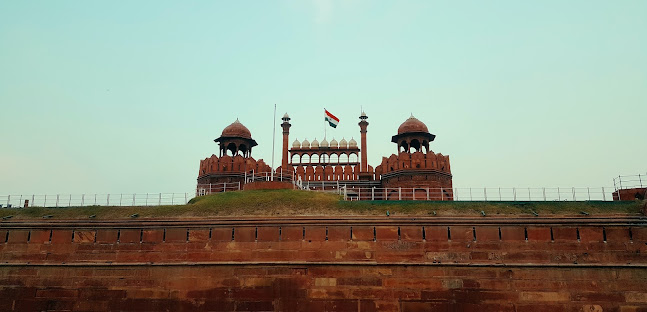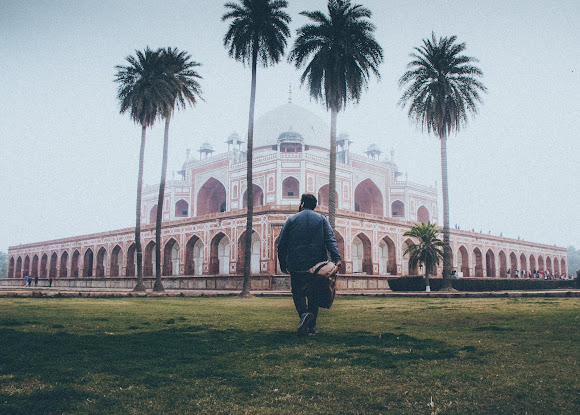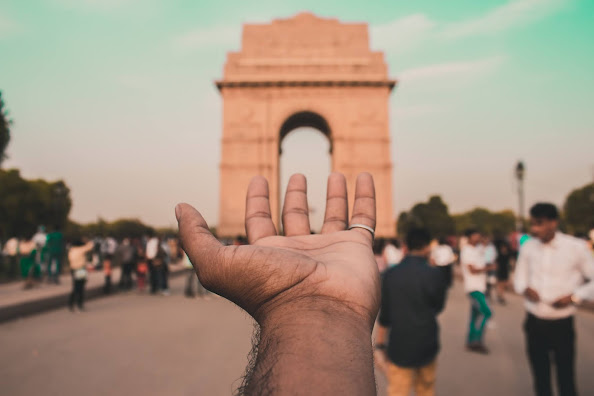The Capital Of India Delhi
Delhi tourist place Red Fort new Delhi
The capital city is one of the most popular tourist places in India. In a city of cultural heritage, historical monuments, different events, and the mouth-watering street food, high-end shopping malls, luxury hotels, and restaurants, bars and cafés, Delhi has something for everyone. So, if you're looking for a heritage walk or go shopping, or have kids, or place it in a photo, or even if you are on the lookout for the blessings of Allah, in New Delhi, you won't be disappointed.
Who build Red Fort (lal Qila):
The Red Fort is an old fort, which is also known as Lal Qila. The fort is spread over 255 acres in size and has a mix of architectural styles including English, Hindi, Islamic, Persian, and Timurid. The red Fort is surrounded by a 25-km-long walls, which are made up of red sand-stone, and, therefore, has its own name-the " Red Fortress. It is situated on the banks of the Yamuna River, and the palace was designed by the famous architect, Ustad Ahmad Lahauri. The construction of this fort is 8 years and 10 months old. In the main room to be visited in the fort are the Diwan-i-Am and Diwan-i-Khas. Diwan-I-Am, it has 60 red brick pillars supporting a flat roof, and has a large entrance hall for a private customer, who used it for government functions, as the Diwan-I-Khas, it was smaller, with a garden made of white marble and used it for official business. Make the most of the precious marble structures of the castle were destroyed by the British during the revolt of 1857. The Red Fort's Gate is the Lahori Gate. The port is so-called because of its orientation towards the city of Lahore. The south side of the entrance to the Instagram-Port a fort.
01.Humayun’s Tomb: Humayun's tomb in Delhi is considered to be the first of the grand dynastic mausoleums that have become synonymous with the Mughal architecture with the architectural style of the "countries of" 80 years later, at the end of the Taj Mahal. The Mausoleum of Humayun, it is located on the territory of the complex with a total area of 27.04 acres, which, among other things, modern buildings.?????????? A 16th-century garden, such as Nila Gumbad, Isa Khan, Bu Halīma, Instagram, and the Barber shop in the morning, it's good for the craftsmen in the construction of Humayun's Tomb and continued to be, the Arab Serai.
Humayun's tomb was built in the 1560s under the patronage of Humayun's son, the great Emperor Akbar. Persian and Indian craftsmen worked together to build the garden, and a grave is much greater than that of a mausoleum been built before in the Islamic world. Humayun's tomb garden is a preview of a charbah (in the garden of the four squares with the four rivers of the Qur'an, Paradise is), with pools joined by channels. The garden is south-facing and west-facing, high-wire fences, outbuildings, is located in the heart of the eastern and northern walls.
The mausoleum itself is located on a high, broad, sloping apron with two deep-vaulted rooms on all four sides. The evil is the layout plan of the four long sides and beveled edges. It has a double-domed 42.5 m in height, and covered with a marble top, supported by columns, and kiosks (chatris, and the domes of the main chatris are decorated with glazed ceramic tile. One half of each side is a deep-rooted due to the large curved arches, a series of smaller ones built into the wall.
02. Jama masjid: (Friday Mosque), Delhi is the largest and perhaps the most prominent mosque in the country. It is located on the other side of the street to the Red Fort. The Great Mosque of Old Delhi, is the latest architectural extravaganza of the Mughal Emperor, Shah Jahan with a courtyard capable of 25,000 worshippers. The mosque measures 65m by 35, and in the courtyard to form a 100m square). Built in 1656, this is a vivid reminder of the Mughal religious fervor. The large courtyard is ideal for a maximum of one thousand believers, that their prayers here.
It is also known as " Masjid-e-Instagram ", or" The great Mosque, which is Prevalent all over the World. It is designed to be the most important mosque of the Emperor and the..? A distributed, located between the main road.
Located in the old city of Old Delhi, this monument was built by the five-thousand visitors. This beautiful house is located in the post office, Jhal, one of the two hills in the ancient Mughal capital of Shahjahanabad. In the orient, the monument is centered on Lal Kila (Red Fort), and it has three gates, four towers and two minarets. It is constructed of alternating vertical strips of red sandstone and white marble. The three domes, extensive use has been made of a white marble, and it was bordered by black lines.
The building is located on a very high platform, so that its beautiful facade visible from all the surrounding areas. A wide flight of stairs leads to the drawing of the ports on the north and the south. The broad stairs and the arched gates of the features of the popular mosque and hagia sophia. To the west of the entrance, which was probably used by the emperors, remains closed during weekdays. The most important of instagram hallway on the west side, which is decorated with a series of tall pointed arches on the 260-columns, which need about 15-marble domes in a variety of sizes. Those of you who are giving this track is on the majority of days, but on Friday, and on other holy days. To the South of the Sea, the area is a 1,076-square-meter area, in which 25,000 worshippers concurrently with each other, and to sit in front of namaz (prayer).
As the Emperor of India, and is said to have built the Jama Masjid, the Rs 10 crore, and it can be said that it is a replica of the Mochi that is Good in the Restaurants. It combines the best of Hindu and Muslim architectural styles.
In the shade of a centuries-old monument, which is on the stairs in a narrow little streets, the whole life style of life, a microcosm of India itself, it tells you all about the rich cultural heritage of India.
03. India Gate: The India Gate, is officially called the Delhi Memorial, originally called the All India War Memorial, it is a monumental sandstone arch in New Delhi, dedicated to the troops of the British India, who died in the war, between 1914 and 1919. The India Gate is located in the eastern part of the Rajpat (formerly called Kingsway), is a 138-foot (42 m) high.
The India Gate is one of the many of the Uk's landmarks are in command of the Imperial Tombs of the Committee (later renamed the Commonwealth Graves Commission. The architect, Sir Edwin Lutyens, an Englishman, who designed many other war memorials, and it was also the most important artists of the New Book. The foundation stone was laid in 1921 by the then Prince of Connaught, the third son of Queen Victoria. The construction of the All-India War Cemetery, as it was called, it wasn't until 1931, the year of the official announcement of New Delhi, the capital city of India.
Lutyens wanted to take the bows, and other Asian motifs in his project but, instead, strive to keep it simple. The result is often referred to as being analogous to the Arc de Triomphe in Paris, france. On the roof, on top of the bow, a wide, shallow bowl is in the shape of a dome, a place to fill with burning oil to your special occasions. No bonfires are lit on the roof in the last few years, however, the four eternal flames, now located at the foot of the building. The flame is pointing to the Amar Jawan Jyoti, a small monument, which has served as India's tomb of the Unknown Soldier, since 1971. Make the most of the instagram dedications to the theaters of war during the first world War, but in the Third Anglo-Afghan War as well. The names of the individual, of the Indian soldiers, more than 13,000 of them, according to the Commonwealth Graves Commission, and are written on the memorial in lower-case letters.
04.Qutb Minar-Delhi: Qutb Minar and its surrounding attractions in new Delhi
Built in the early 13th century, a few kilometres south of Delhi, the red sandstone, Qutub Minar Tower is 72.5 m high, tapering from 2.75 m in diameter at the peak to 14.32 m at the base, and are interspersed with pointed and rounded corners. In the immediate vicinity of the archaeological site of his funerary structures, and, in particular, from the magnificent Alai Darwaza Gate, the masterpiece of Indo-Muslim art (built in 1311), and two mosques, including the Kuwatul in the World and the oldest in northern India, built of materials reused by some 20 Brahman temples.
05. Red Ford: The Red Fort also known as Lal QalʿAh, also spelled Lal Qila, or Lal Qila, is a Mughal fort, new Delhi, India. It was built by Shah Jahan, in the mid-17th century, and it continues to be a major tourist attraction. The fort was declared a UNESCO World Heritage Site in 2007.
The fort is a huge 75-foot (23 m) red sandstone walls surrounding a complex of palaces and entertainment, exhibition halls, projecting balconies, pools, and is covered with canals, geometrical gardens, and a pretty terrace. One of the most famous buildings in the complex are in the Public Auditorium Hall (Diwan-i-Am), which is 60 red sandstone pillars supporting a flat roof, as well as its Own Auditorium and Hall (Diwan-i-Khas), which is smaller, with a white marble pavilion.An early-the red fort, which was built in Old Delhi, in the 11th century as a result of the Tomara King Anangapala. Qutb Mosque, and now stands on this site.
06. Hazrat Nizamuddin Auliya Dargah (Hazrat Nizamuddin Dargah): Hidden amidst the busy streets, and in the West in the Nizamuddin area, Hazrat Nizamuddin Aulia Dargah (Nizamuddin Dargah) of mausoleum ? Saint Nizamuddin Aulia, who lived in the 13th and 14th centuries. It attracts people from all parts of India, as well as music lovers, a visit to the to the to listen to the traditional, instagram music, Qawwali is on a Thursday.
07. Chandni Chock: Well-known for its historical significance, as well as many shops, the mayhem and the delicious local food, Chandni Chowk, which is one of the oldest markets in Purani Dilli (Old Delhi, in the case of English). Established in the 17th century by the Mughal ruler Shah Jahan of India, this place offers great views of the Instagram Mosque, and is located across from the Red Fort.
Along the bustling Chandni Chowk Street, carriers, and vendors in the line-up of the medieval bazaar-like landscape. This is an important historical site, known colloquially as " the area where all of the types of products that are being sold, to you. Since its inception, Chandni Chowk has always been known as the Center of the Buyers in India.
Shopping in this city is a very fun and interesting, if the market as a whole, it is divided into a number of narrow streets, each of which are selling a lot of different kinds of jewelry, clothes, shoes, bags, electronic products, household appliances, decorative items, statues of Gods and Goddesses, and accessories.
In addition, since the Chandni Chowk is a wholesale market place, customers can expect deep discounts on almost all products. This place is also a paradise for merchants. In addition to that, it is a amazing shopping, Chandni Chowk is also a paradise for food lovers.
There are a lot of restaurants that serve tasty Indian snacks and street food like Chole Bhature, Dahi Bhalle, Gol Gappe, Daulat Ki Chaat, Aloo Chaat, Kulfi, Kebabs, Ram Ladoo, and Chole Kulche.











0 comments